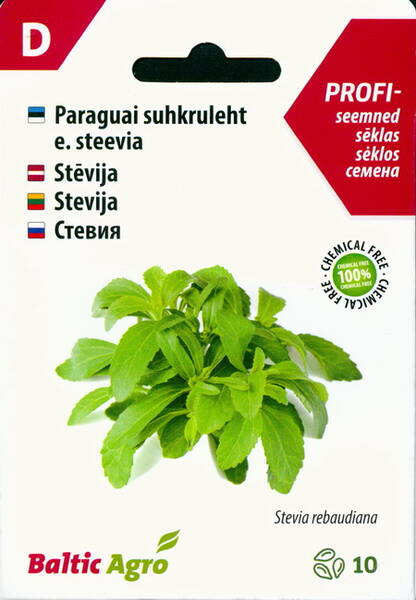300 times sweeter than sugar! Delicious medicine!
Height 60-80 cm Perennial subtropical plant, grown in the middle lane as an annual.
Stevia leaves contain a glycoside - stevioside, which is 300 times sweeter than sucrose. Unlike sugar, it has no side effects.
It is a low-calorie sugar substitute for patients with diabetes mellitus, impaired carbohydrate metabolism, and cardiovascular diseases.
The leaves are used fresh, dried, in the form of syrup and extract.
1 gram contains 2700 seeds.
Growing conditions.
Sowing seedlings in light, rich, well-drained soil, shallow (not incorporating). Seeds germinate at an optimum temperature of +18+20 C.
Do not allow drying and waterlogging of the soil. Cutting shoots are produced 16-18 weeks after germination.
Before frost, you can transplant the plant into a pot, grow it indoors, or dig up only the rhizome and store it cool until the next season, covered with mail.
Sowing: January-February.
Transfer: May (3) - June (1.2).
Harvest: June (2.3)-August.
BENEFICIAL FEATURES.
The leaves of this plant contain stevioside, the composition of this complex substance includes glucose, sucrose, steviol and other compounds.
To date, stevioside is the sweetest product of plant origin, it is about 300 times sweeter than ordinary sugar.
But its special value lies not in this. Due to its low-calorie content, stevioside does not increase blood sugar levels,
Therefore, even diabetic patients can use it. In addition, stevia contains a large complex of vitamins, essential oils, minerals, flavonoids.
The plant has an antifungal and mild antibacterial effect and is also a natural preservative, which makes it indispensable in homemade preparations.
FEATURES OF GROWING.
In nature, stevia reaches about 60-80 cm in height, the bush is highly branched, the flowers are small, white. The plant prefers moist, sunny, wind-sheltered areas.
Stevia has a long growing season, so in temperate climates, as well as northern latitudes, it is recommended to grow it through seedlings.
In these climatic zones, her seeds usually do not ripen. Under stevia, it is desirable to allocate the most illuminated and warm areas.
The temperature of +22...+28°C is optimal for the growth and development of plants; when planting through seedlings, it should not fall below +15°C.
The soil should be light, loose, sandy or sandy loam (peat is not recommended), slightly acidic (pH 5.5-6).
Seeds are sown without embedding in the ground, then covered with a film or glass.
At home, to make it easier to control the germination process, you can sow on a dark cotton cloth, pre-moistened.
The seeds are covered from above with the same cloth, and then they keep them moist.
After the seeds have hatched, they are very carefully (using tweezers) transferred to moist prepared soil and planted to a depth of no more than 0.5 cm.
Plants are planted in the open ground when the threat of frost has finally passed (in late May-early June). Landing is best done in the evening or on cloudy days.
The recommended distance between plants is 25-30 cm. Plantings are watered with warm (+25...+35°С) water.
Stevia does not tolerate drought well and needs frequent watering, stagnant water also has a bad effect on the condition of plants.
Eng.: Sugar Leaf, Candyleaf, Stevia, Sweet herb, Sweet herb of Paraguay. Bot. syn.: Eupatorium rebaudianum Bertoni.
PREPARATION "SUGAR".
The collection of leaves and small stems begins during flowering, the stems are cut at a height of about 6 cm from the surface.
Then they are tied into small bundles or laid out in a thin layer on paper under a canopy or in a ventilated room.
Stevia leaves and stems are about 6-8 times sweeter than sugar. Thus, at home, with 1 m2, you can get a crop equivalent to 6 kg of sugar.











